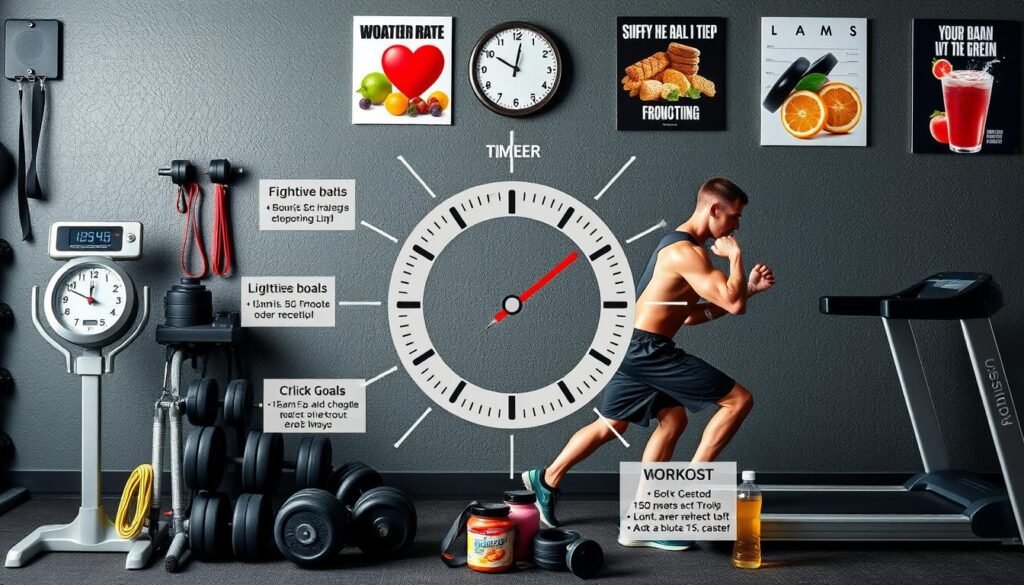Did you know about 25% of athletes face a drop in their game because of overtraining? This surprising fact highlights the tightrope walk between pushing hard and knowing when to stop. Overloading is when you push a muscle till it’s thoroughly tired. It’s a key idea for those into strength training and bodybuilding. By asking more of our muscles than they’re used to, we see benefits like more strength and bigger muscles. This knowledge is crucial for athletes wanting to get better without overdoing it.
Slowly upping how hard we train not only tires out muscles but leads to better changes in our bodies. By wisely using overload principles, athletes and gym fans can enjoy the pluses of tough workouts without falling into the overtraining trap. For more on how overtraining can mess with your mind, check out overtraining syndrome.
Key Takeaways
- The principle of overload is crucial in strength training and bodybuilding.
- Overload leads to meaningful adaptations such as strength and muscle growth.
- Finding the right balance in training can prevent the risks of overtraining.
- Rest and recovery are essential to support both physical and cognitive functions.
- Understanding muscle fatigue is key to maximizing performance and longevity in sports.
Understanding Muscle Fatigue
Muscle fatigue happens when you push your body hard, and it uses energy faster than it can use oxygen. Your body tries to keep up with the fatigue. Slow-twitch fibers are better at resisting fatigue than fast-twitch fibers. This helps endurance athletes perform for longer times. Training can boost your aerobic capacity, helping you fight fatigue without changing muscle types.
With long exercise, your body runs low on glycogen, lowering how well you perform. Also, more reactive oxygen species are made, which are important in causing fatigue. When tired, your muscles can’t generate as much force. Ca2+ sensitivity in muscles decreases, and Ca2+ release from reserves slows down.
Recovering from fatigue can take days for muscles to get back to full strength. Athletes often don’t rest enough. Yet, not resting can lead to burnout. This drop in performance and feeling worn out shows why managing training is key.
To watch their training, athletes look at heart rate, how hard they feel they’re working, and power output. These measures help them see changes in performance and manage fatigue better. It’s critical to understand how physical and mental factors play into muscle fatigue. This knowledge helps improve training strategies and sports success.
| Fatigue Mechanism Components | Description |
|---|---|
| Actomyosin Cross-Bridge Function | Decreased ability to generate force due to fatigue during physical exertion. |
| Myofibrillar Ca2+ Sensitivity | Reduced sensitivity affects muscle contraction performance. |
| Sarcoplasmic Reticulum Ca2+ Release | Slower release of Ca2+ impacts muscle activation and force generation. |
What is Overload Training?
Overload training is when you up the resistance, volume, or intensity in your workouts. It’s all about driving training adaptations. The main aim is boosting muscle growth and enhancing endurance by always posing new challenges. Athletes use overload training to make their muscles tired on purpose. This tiredness is key for making muscles grow. This can be done by adding more weight over time, changing how intense the exercises are, or planning the training in phases.
One way to do overload training right is by adjusting exercises based on what you can do, especially if you’re recovering from an injury or just starting out. This approach helps athletes keep good form and fight off tiredness. It’s really helpful for newbies. It lets them get better gradually while staying safe. They learn the right way to do exercises before moving on to harder ones.
When you add overload training to your routine, it can greatly improve your athletic skills. This includes getting stronger, more powerful, and having better endurance. Ways to do overload training are:
| Method | Description |
|---|---|
| Incremental Weight Increase | Slowly add more weight, about 2-5%, every week or two. |
| Repetition Increase | Do more reps with the same weight until it’s too easy, then add more weight. |
| Adding Sets | Add one more set of exercises every week or so. |
| Decreasing Rest Times | Cut down on rest by 10-20 seconds every week or two to push your body harder. |
Sticking with overload training makes your muscles adapt and can boost your metabolism. More muscle means burning more calories even when you’re not moving. To build muscle effectively, aim for about 1 gram of protein per pound you weigh. This makes sure your body gets what it needs to grow. By following these tips, you’re on your way to better performance and health.
Overload is the Act of Exercising a Muscle to Fatigue
Understanding overload training means knowing a few key terms. These terms help us see how the right kind of stress improves how we perform and recover. Functional overreaching means a short-term drop in performance because of more training. And nonfunctional overreaching can lead to a bigger drop and maybe even burnout. These ideas are really important when it comes to working our muscles hard.
Definitions and Concepts
To grasp how exercise makes muscles tired, it’s good to start with overload’s meaning. By learning about exercise concepts, we can play with aspects like how hard, how much, and how often to train. This lets athletes create training plans that push them just enough without going overboard.
The Science Behind Muscle Fatigue
Looking into muscle fatigue’s science, we learn about the body’s reactions to tough training. Muscles working hard produce lactic acid, which creates a burning feel. At the same time, the body uses up its glycogen, hurting performance. There’s also neural fatigue, affecting muscle communication. These points show the detailed biology behind getting tired from exercise and why knowing this matters.
Benefits of Progressive Overload
Progressive overload is key in effective strength training. It involves gradually increasing the body’s workload. This leads to many workout benefits that boost strength and muscle performance. This method helps muscles adapt and grow stronger over time.
Enhancing Strength Training
The big win of progressive overload is how it boosts strength training. By adding more weight, doing more reps, or increasing intensity, muscles get stronger. This makes muscles more resilient. Athletes see big benefits like stronger bones and improved movement patterns.
Changing up the routine by adding sets or changing exercises ensures progress keeps coming. This keeps lifting abilities growing.
Promoting Hypertrophy and Muscle Growth
Hypertrophy means muscles are getting bigger, thanks to progressive overload. This cycle of tension and rest allows for muscle size increase. Pushing limits with drop sets or supersets increases muscle stress. This is key for muscle growth.
Getting the balance right between how hard you work out, rest, and what you eat is crucial. For newcomers, growth happens quickly. But for those more seasoned, it takes time. This highlights why workouts must keep evolving.

To understand more about resistance training, using good resources is a great idea. For more info, readers can check out this link.
Different Types of Workouts to Achieve Overload
There are many ways to achieve muscle overload, each with its own advantages. Workout varieties allow people to tailor their routines. This makes it easier to reach personal fitness goals.
High-Intensity Interval Training (HIIT) is perfect for those wanting quick, impactful workouts. It mixes short, intense exercises with brief rests. This boosts the heart rate and burns a lot of calories. Plus, HIIT can vary to keep things interesting and challenging.
Resistance training focuses on strength through external weights. As you use heavier weights over time, your muscles grow stronger and bigger. Studies show the more you train, the better the results.
Circuit training combines strength and cardio in a fast-paced workout. You quickly move from one exercise to another with little rest. This keeps your heart rate up, improving endurance. It also engages different muscles for a well-rounded workout.
To grow muscles, mix up your workouts. Try shortening rest times or using new, harder exercises. Staying committed and varying your training will challenge your muscles. This leads to better performance and outcomes.
Factors Affecting Workout Intensity
Workout intensity is shaped by several elements. It’s crucial for athletes and fitness fans to understand their effects. These include training frequency, volume, and rest strategies. Together, they influence workout results and help avoid burnout.
Frequency and Volume in Training
Training frequency and volume are key for workout intensity. Keeping an eye on these factors helps tweak performance. Athletes balance training frequency—how often they train—with training volume—the work amount in a session. Wrong adjustments can lower benefits or raise fatigue.
Athletes should only boost intensity, duration, or frequency by 10% each week. This slow increase lets the body adapt safely. It lowers injury risks and boosts performance. It shows the need for customized training plans. Sports players should check their progress and energy levels often.
Importance of Rest and Recovery
Rest and recovery are vital for training success. Not enough recovery can stop muscles from adapting well. This raises the chance of overtraining and exhaustion. Good sleep, active recovery, and health tracking can lower these problems. Ignoring rest leads to issues that can affect performance for days or weeks.
The idea of glycogen depletion underlines eating right for muscle recovery. Refilling glycogen after work-outs is essential. So, focusing well on training management and reviewing rest habits are key. Athletes need to see rest as a crucial part of their training routine.

Common Mistakes in Overloading
Overloading properly needs careful thought. Many athletes mess up in overload training. This can slow them down or cause injuries. A big mistake is not using progressive overload right. This method means slowly making workouts harder to grow muscles.
To do better and make fewer mistakes, athletes should slowly add more weight or do more reps. They need to keep track of their workouts, maybe with a logbook or spreadsheet. This helps apply progressive overload well. Athletes can then see where they need to improve.
Some people forget to set clear goals for how many reps to do. It’s better to aim for a range instead of just one number. This helps tire out the muscles and improves how you perform. Starting with small weights, like 2.5 and 5 pounds, helps too. This makes it easier to get better over time.
Here are some key mistakes in overload training to avoid:
- Not applying the progressive overload principle consistently.
- Neglecting performance tracking, leading to stagnation.
- Focusing solely on specific rep numbers rather than rep ranges.
- Skipping recovery protocols, risking burnout.
- Overloading too quickly without allowing muscle adaptation.
Progressive overload is about slowly increasing what you do to push yourself more. It helps keep you from hitting a wall and builds muscle. Using High-Intensity Training (HIT) follows these ideas. It lets athletes push hard in short, intense workouts.
| Mistake | Description | Consequence |
|---|---|---|
| Ignoring progressive overload | Failing to increase weight or intensity | Stagnation in progress |
| Neglecting recovery | Insufficient rest time between workouts | Increased risk of injury |
| Overloading too quickly | Increasing volume or intensity drastically | Burnout and fatigue |
| Lack of tracking | Not recording workouts or progress | Difficulty in identifying areas for improvement |
| Focusing on specific reps | Limiting to a set number instead of a range | Restricting growth opportunities |
Knowing about these mistakes can help athletes fix their training. Success in long-term strength training comes from spotting and correcting these errors. This leads to better results and performance.
The Role of Nutrition in Muscle Fatigue
Nutrition plays a key role in fighting muscle fatigue and enhancing performance. Eating right helps boost energy for those in intense training. It’s important to get the perfect mix of carbs, proteins, and fats.
Energy Sources for Strength Training
Carbs, proteins, and fats are essential for energy during workouts. People who lift weights need 1.4 to 1.7 grams of protein per kilogram of body weight. So, a 170-pound guy should eat about 70 to 170 grams of protein each day. Protein not only powers your workouts but also helps muscles recover. It should make up 15 to 30% of all the calories you eat to keep energy levels high for tough exercises.
- Carbohydrates provide quick energy and refill energy stores in muscles.
- Proteins help fix muscles and make them grow.
- Fats are important for energy, especially during long workouts.
The Importance of Hydration
Staying hydrated is key for muscle work and keeping fatigue away. Not drinking enough can lower how well you train. Athletes need to drink plenty before, during, and after working out. This helps them perform their best. There are rules for how much to drink based on your weight and how hard you exercise. Here are a few tips:
- Drink water before working out to start off hydrated.
- After a tough or long workout, drinks with electrolytes can help.
- Keep track of how much you sweat to know how much water you need.
Recognizing Signs of Overtraining
It’s important to know the signs of overtraining. This is for any athlete or dedicated individual. Overtraining syndrome shows up through various signs. These might get missed while chasing fitness milestones.
Common signs of overtraining include:
- Chronic fatigue that does not improve with rest
- Mood alterations, such as increased irritability or anxiety
- Diminished performance during workouts
- Physical ailments, including joint or muscle pain
Training too hard can lead to overtraining syndrome. For example, training seven to nine times weekly might lower performance. It can also increase physical issues. Symptoms include leg swelling and high heart rates during easy workouts. Too much training can cause physical and mental health problems, like anxiety and weaker strength.
Overtraining can harm muscle health. Constant muscle tension can cause scar tissue. This bad for circulation and flexibility. It affects overall athletic performance. Work stress and personal life problems can make overtraining worse. This shows that overtraining is not only about how much or how hard you train.
Monitoring heart rate variability (HRV) can help catch overtraining early on. A low HRV can signal overtraining. This suggests it might be time to look at how much you’re training. It’s crucial to adjust training and recovery to protect health and performance.
Strategies to Prevent Overtraining Syndrome
Preventing overtraining syndrome is essential for any athlete or workout enthusiast. Smart and effective training approaches help a lot. As many as 60% of elite athletes might suffer from it, showing how crucial prevention is.
To avoid overtraining, here are some tips:
- Implement progressive overload: Increase workout intensity and volume slowly to allow your body to adapt.
- Prioritize recovery: Make sure to rest and mix up your workouts. This stops you from overworking the same muscles every day.
- Nutrition matters: Eat well, focusing on protein to help muscles recover and fight off fatigue.
- Self-monitoring: Listen to your body and mind. If you feel overly tired or sore for too long, it might be overtraining.
- Mind your heart rate: A higher resting heart rate after working out could mean you’re overtraining. Keeping an eye on it helps balance your workouts.
Adding these strategies to your workout plan can boost performance and lower the risk of overtraining. Research, including guidance from the National Academy of Sports Medicine, shows that a balanced approach to training is key to better results.
| Strategy | Description | Benefits |
|---|---|---|
| Progressive Overload | Gradually increasing intensity | Improved strength and adaptation |
| Prioritize Recovery | Including rest days, avoiding daily intense training | Enhances muscle recovery and performance |
| Nutrition | Balanced diet focusing on protein intake | Supports recovery and minimizes fatigue |
| Self-Monitoring | Observing signs of fatigue or performance decline | Early detection of overtraining risks |
| Heart Rate Monitoring | Tracking resting heart rate post-exercise | Indicates training load effectiveness |

Conclusion
Understanding overload is key. It means pushing a muscle until it’s very tired. This is vital for growing stronger and performing better. Benefits are not just physical. They include mental toughness and better health. Knowing how our bodies react to exercise helps us make better workout plans.
Good nutrition and staying hydrated are also important. They play a big part in how well we recover and perform. Balancing exercise with enough rest is crucial. Without rest, we risk overdoing it. This can make us weaker over time and mess up our training goals.
To avoid such problems, we should focus on eating right and resting enough. This helps us make the most of our workouts. For more tips on staying healthy with physical activity, see our guide on the benefits of flexibility. It talks about how stretching can ease stress and make you feel better, both in mind and body.